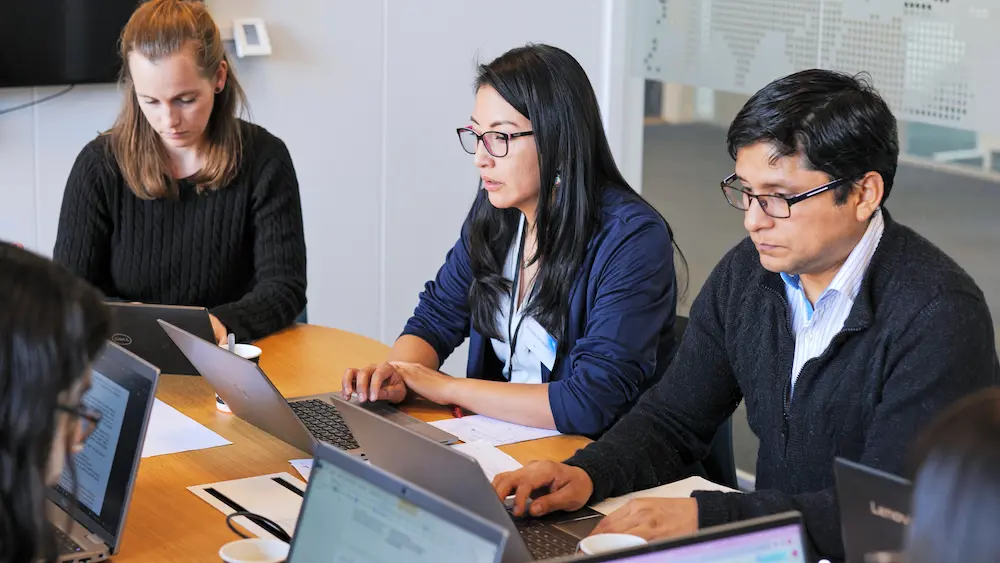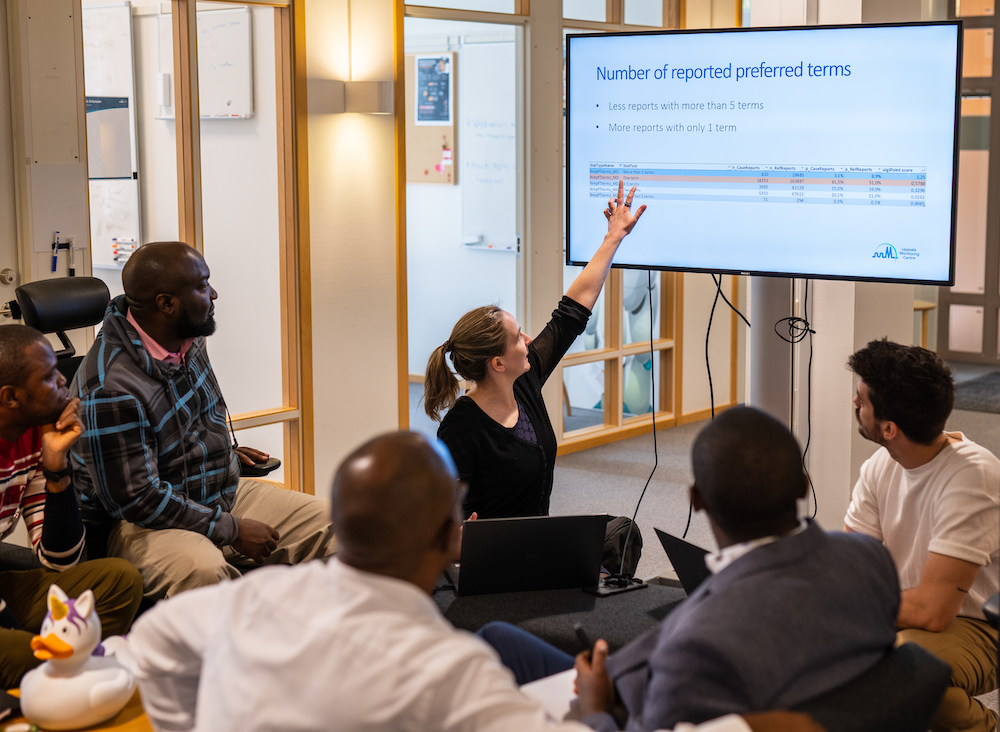
In May this year, UMC hosted an advanced course in signal detection at its headquarters in Uppsala. Eighteen people from 12 countries (the British Virgin Islands, Egypt, Georgia, Mexico, Montenegro, Paraguay, Peru, Rwanda, Sierra Leone, Slovenia, Zambia, and Uganda) took part, bringing with them relevant drug-ADR combinations to work with over the weeklong course.
There are many moving parts to a course such as this, which was a year in the planning. But finally, it’s all about getting down to the practical details of signal detection and causality assessment under the tutelage of UMC’s experts in signal management, pharmacovigilance science and data science.
Here, Annette Rudolph, Monica Tarapués, Alem Zekarias, and Eva-Lisa Meldau report back on their experience as teachers on the course. But first some general observations.

Annette Rudolph and Monica Tarapués of UMC work alongside Cesar Avalos of DIGEMID, Peru
They all agreed how inspirational it was to meet people from not one but several regions working for the same purpose as UMC. In Rudolph’s words, “their dedication and motivation made an intense week of work fly by”.
Tarapués noted that several participants were sharing their experiences with other member countries of the WHO Programme for International Drug Monitoring for the first time. “It was a welcome opportunity for them to discover the value of being part of this network. Sometimes we underestimate the importance of these forums and their impact on pharmacovigilance,” she said.
Nor is it a one-way street. “You may think that they came to learn from us, but we learnt just as much from them, from their needs and challenges to what their PV practices look like,” Zekarias said.
What would you say is their biggest challenge?
MT: One of the biggest challenges in these countries is to separate the political from the technical. Sometimes decision-makers do not fully comprehend the science, resulting in a good PV analysis sitting in a desk drawer for years, and worst-case scenario, forever. This is an issue for many national centres, and hard to solve. Another inherent difficulty in analysing spontaneous reporting data is that it doesn’t always result in a causal conclusion. But the journey itself also matters and shouldn’t be viewed as a waste of time. This is particularly important for “the understanding and prevention of ADRs and other medicine-related problems” as per the definition of pharmacovigilance. As a PV analyst, it is essential to convert all collected data into information that can be used by prescribers to ensure the safe use of medicines.
AR: Many participants wanted guidance on how to translate their findings from the signal management exercise we did together into regulatory actions. But this is not in our scope, so I had the feeling they taught me more than I could teach them.
MT: Language can also be a barrier; English is our working language, and we assume that English will be a requirement in all national centres, but it’s not. Participants did their best, and the final presentations were excellent, and we were all able to understand each other, but the language gap is something we need to consider in pharmacovigilance in general. Even in English, PV terms are not harmonised, for example.
AZ: The focus of the course was how to assess and evaluate case reports but what we have learnt is that we have got to take some steps back. Case entering and coding reports in VigiFlow seems to be the biggest challenge for all countries, no matter if they are EU countries like Slovenia or low-income countries like Uganda. Many countries have limited resources, which means good infrastructure is critical for keeping up pharmacovigilance. These countries also struggle with paper reports. Entering the data and coding takes time, with the reporter often sharing only parts of reports – the suspected drug and ADR – despite more information that could be relevant to the assessment being available. We see ways to solve this, for example through automation. Prioritising this issue for our VigiFlow users will have an impact on all steps of the PV cycle.
How do you think we have helped?
E-LM: One question that me, Annette, and Monica could help with was signal detection guidelines. For example, while some Latin American countries have small databases where qualitative, case-by-case assessment makes sense, some countries such as Mexico and Peru have more than 100,000 reports and need to prioritise drug-ADR combinations for assessment. We helped them to feel more secure in their arguments, with other data scientists at UMC also joining in for a quick presentation and discussion around disproportionality, which helped answer some of their questions.
AZ: From a pharmacovigilance science perspective, I showed them how the global data could add value to their national data. Instead of trying to assess and evaluate problems that may be of relevance in other parts of the world, they should focus on problems that are relevant to their own population. I also helped them to understand why reporting and coding as precisely as possible is essential and the importance of data entry and coding for analysis. I think they reached the conclusion themselves that “garbage in means garbage out”. Although they struggle with a large amount of data entry, they recognise that they cannot sacrifice coding quality. It was also clear that countries are not using VigiLyze to the full, either to quantitively identify possible signals or as a working tool for assessment.
MT: Putting knowledge into practice is not easy, and that was the course’s main objective. One of our biggest strengths was that we were able to address the questions regarding data and methodology that arose during signal validation and assessment. Understanding the power and limitations of the data is essential. It is a PV skill that is only developed through experience.
What did you learn from the course?
MT: There is room for improvement in what we do for programme members. My take home was that I need to push myself more to understand their needs. One way could be to make the online course more personal to really get to know them, focusing not only on their PV skills but also on what they are doing at national centres to better understand their realities.
E-LM: It gave me a better understanding of what pharmacovigilance work looks like for most of our VigiFlow users.
AZ: Two things that I’ll take with me are, 1. Less is more: solving the problems with reporting and coding could have a big impact, and 2. There are other stakeholders out there that may want to provide countries with solutions that are not always compatible with certain standards or regulations.
AR: Directly interacting with people from national centres all over the world has helped me to better understand the difficulties they face in their work. It’s also given me a fresh perspective on the data I work with day in, day out. I really hope I will get more opportunities like this.
Read more:
For more information on pharmacovigilance education and training see UMC’s website




